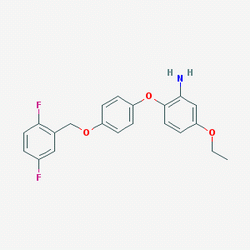| Description: |
SEA0400 is a novel and selective inhibitor of the Na+-Ca2+ exchanger (NCX), inhibiting Na+-dependent Ca2+ uptake in cultured neurons, astrocytes, and microglia with IC50s of from 5 to 33 nM. |
| Target: |
IC50: 5-33 nM (NCX) |
| In Vivo: |
SEA0400 (3 mg/kg + 3 mg/kg/h for 2 h, i.v.) attenuates the infarct volume in the cerebral cortex and striatum, does not affect the mean the regional cortical blood flow in anesthetized rats[1]. SEA0400 protects against the dopaminergic neurotoxicity (determined by dopamine levels in the midbrain and striatum, tyrosine hydroxylase immunoreactivity in the substantia nigra and striatum, striatal dopamine release, and motor deficits) in MPTP-treated C57BL/6J mice[3]. |
| In Vitro: |
SEA0400 inhibits Na+-dependent 45Ca2+ uptake in cultured neurons, astrocytes, and microglia. IC50 values of SEA0400 are 33 nM (neurons), 5.0 nM (astrocytes), and 8.3 nM (microglia)[1]. SEA0400 prevents sodium nitroprusside (SNP) to increase ERK and p38 MAPK phosphorylation, and production of reactive oxygen species (ROS) in an extracellular Ca2+-dependent manner[2]. |
| Kinase Assay: |
Na+-Ca2+ exchange activity is determined by assaying Na+-dependent 45Ca2+ uptake as reported previously. Briefly, the cells are preincubated in Hanks' balanced saline solution (HBSS) for 20 min, and the medium is switched to HBSS containing 45Ca2+ and incubated for 5 min. To increase intracellular Na+ concentration, 1 mM ouabain plus 20 μM monensin (for astrocytes and microglia) and 10 μM monensin (for neurons) are used. Monensin is added simultaneously with the isotope. Ouabain is added 5 min before monensin in astrocytes and microglia. SEA0400 and KB-R7943 are added 5 min before monensin and present during 45Ca2+ uptake reaction. |
| Cell Assay: |
Cells, plated in 96-well plastic tissue culture plates, are incubated at 37°C for 30 min in normal or Ca2+-free HBSS containing 10 μM H2DCF-DA and 0.25 μg/mL Cremophor EL, and then rinsed twice with normal HBSS to remove excess dye. The cells are reperfused in normal HBSS for 1 h, and the conversion of H2DCF-DA to its fluorescent product dichlorofluorescein by ROS, presumably H2O2 and hydroxyl radical, is determined with excitation at 485 nm and emission at 535 nm using a Wallac Multilabel counter. ROS production is expressed as a percentage of control cells. The linearity and sensitivity of ROS assay are confirmed using H2O2 prior to the experiment. SEA0400 at the indicated concentrations is added 10 min before Ca2+ reperfusion and present until assay. |
| Animal Administration: |
Male Sprague-Dawley rats, weighing 289 to 325 g, are anesthetized with 1 to 2% halothane. A catheter is inserted into the femoral artery and connected to a pressure transducer to record blood pressure. Regional cortical blood flow is measured by a laser Doppler flowmeter, with probe placement at 2 mm posterior and 6 mm lateral to the bregma. SEA0400 or its vehicle with an equivalent volume is i.v. injected at 3 mg/kg and then infused at 3 mg/kg/h for 2 h under normal conditions without MCA occlusion. |
| References: |
[1]. Matsuda T, et al. SEA0400, a novel and selective inhibitor of the Na+-Ca2+ exchanger, attenuates reperfusion injury in the in vitro and in vivo cerebral ischemic models. J Pharmacol Exp Ther. 2001 Jul;298(1):249-56.
[2]. Nashida T, et al. The specific Na(+)/Ca(2+) exchange inhibitor SEA0400 prevents nitric oxide-induced cytotoxicity in SH-SY5Y cells. Neurochem Int. 2011 Aug;59(1):51-8.
[3]. Ago Y, et al. SEA0400, a specific Na+/Ca2+ exchange inhibitor, prevents dopaminergic neurotoxicity in an MPTP mouse model of Parkinson's disease. Neuropharmacology. 2011 Dec;61(8):1441-51. |






















